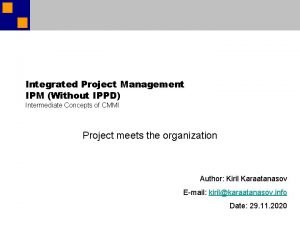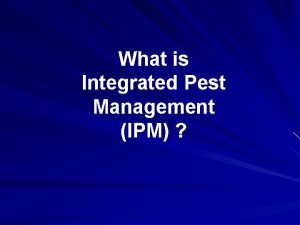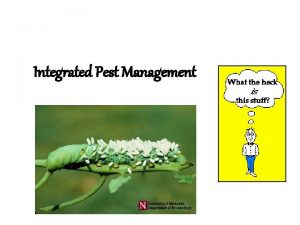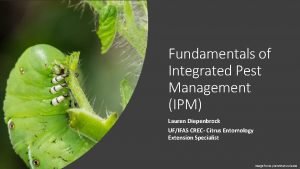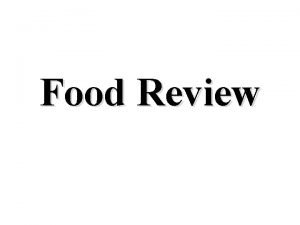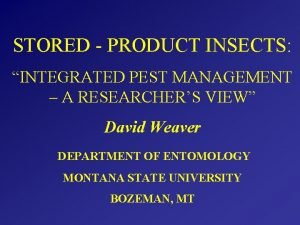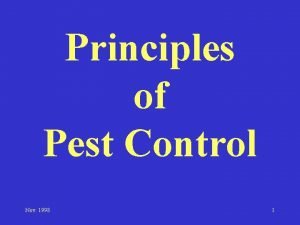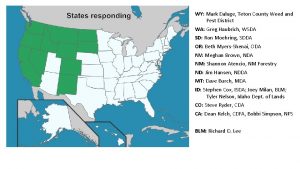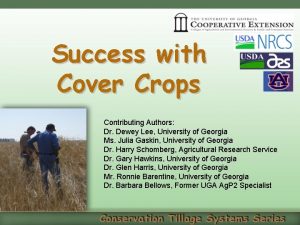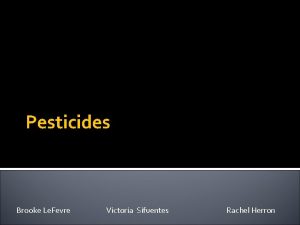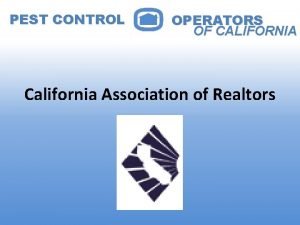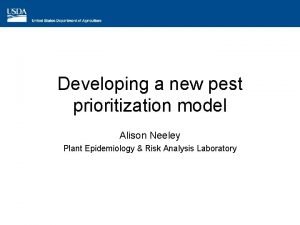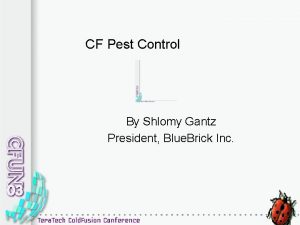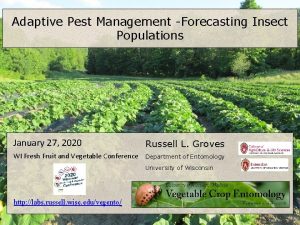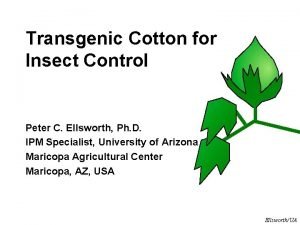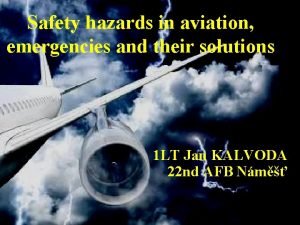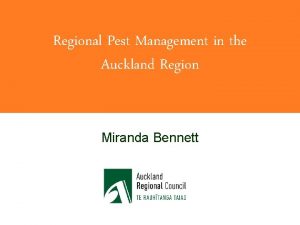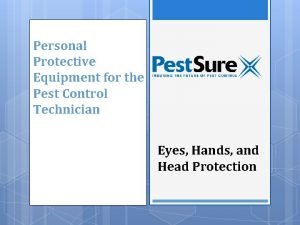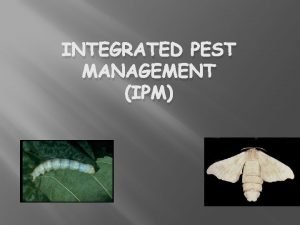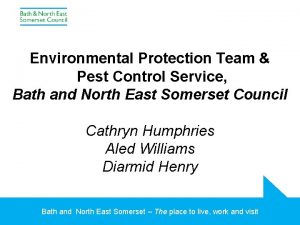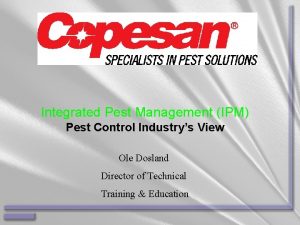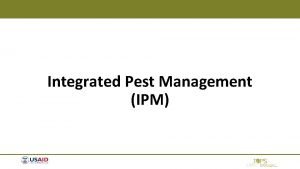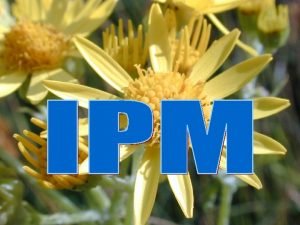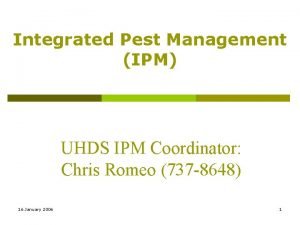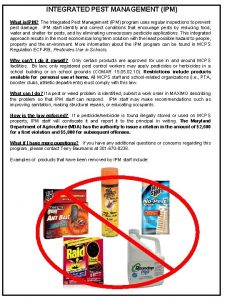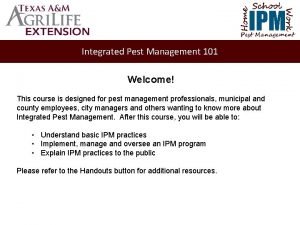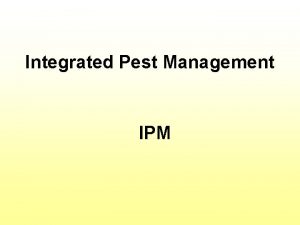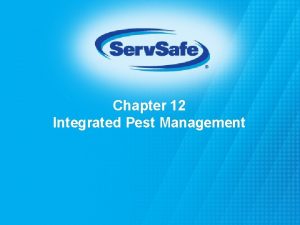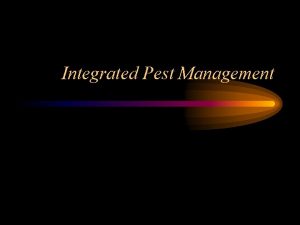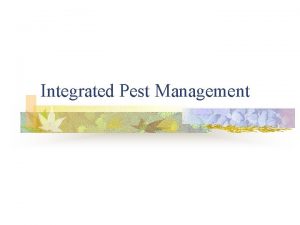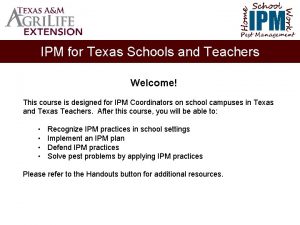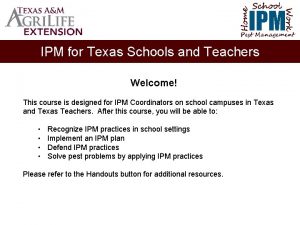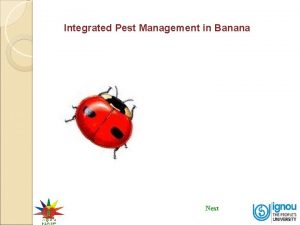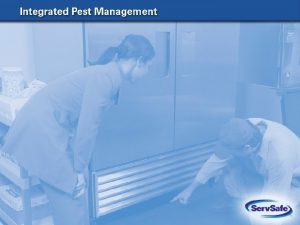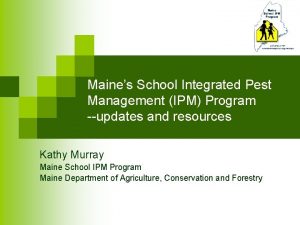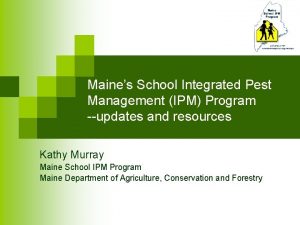Integrated Pest Management IPM NJDEPPesticide Control Program Principles




















- Slides: 20

Integrated Pest Management (IPM) NJDEP-Pesticide Control Program Principles of IPM for Implementation IPM Minimum Criteria -Structural (Commercial Accounts/Private Residences)

Integrated Pest Management (IPM) Reducing and/or change in pesticide use n an effective & environmentally sensitive approach to pest management n relies on a combination of commonsense practices Benefits Risk n may include the judicious use of pesticides. n

IPM Includes: n n n n Inspection Monitoring pest populations Identifying pests; Determining threshold Developing a plan Implementing the plan Continuing to monitor

NJDEP-PCP General Definition of IPM “IPM is a sustainable approach to managing pests by using all appropriate technology and management practices in a way that minimizes health, environmental, and economic risks. IPM includes, but is not limited to, monitoring pest populations, consumer education, and when needed, cultivation practices, sanitation, solid waste management, structural maintenance, physical, mechanical, biological and chemical controls. ”

IPM Goals Goal of IPM: control pests, not eradicate entire population n Treatments are not made acc. to a predetermined schedule n Based on results of monitoring n Treatments are chosen & timed to be most effective & least disruptive to natural pest controls n

IPM Strategies – IPM Control n Eliminate Food Source n Eliminate Water/Moisture Source n Eliminate Harborage n Eliminate Access

Integrated Pest Management (IPM) NJDEP IPM Minimum Criteria Structural (Commercial Accts. /Private Residences) n. Prerequisites for IPM programs: • Educate Client • IPM principles-what is IPM? How does it differ from conventional pest control? • Risks vs. efficacy of chemical and non-chemical controls • Benefits-reduced risk for humans, pets and non-target organisms with appropriate choice of controls and methods • Proper sanitation and exclusion • Client’s role in IPM-what is their responsibility when the Commercial Applicator leaves their property?

Integrated Pest Management (IPM) NJDEP IPM Minimum Criteria continued. . . n. Customer Involvement • Act on recommendations of IPM Practitioner to correct potential pest problem areas • Document and report pest sightings between visits n. Credentials of the IPM Practitioner • NJDEP Commercial Pesticide Applicator license and certification (category(ies) 7 A, 7 B or 7 D) • NJPMA accredited wood destroying organism inspector (for services relating to 7 B inspections), if possible • professional association membership • access to urban entomologist

IPM Minimum Criteria cont. n. Monitoring • Monitor your progress • Monitoring tells you what works and what doesn’t work n. Mechanical-traps, mechanical devices, glue boards, sticky traps, insect light traps, pheromone traps • useful for monitoring the type and abundance of many types of pests

Monitoring Devices n. Inspected on each service visit used as indicators of pest problems n identify the pest and degree of infestation n location of the problem n change in population-are numbers increasing or decreasing over time? n Determines Action threshold n Control method for small numbers of pests n Preferred method for areas requiring nonpesticide use n

n Visual Monitoring Visual inspections n Knowledge of interior structure • • n Structural deficiencies, moisture problems, sanitation issues Inspect behind moldings, baseboards, under furniture, inside tubular frames, cracks and crevices, other areas of harborage Visual monitoring tools flashlight n mirror n hand lens n gloves n sticky traps n evidence of pest - nymphs, egg cases, shed skins, feces, gnawing, tracks, grease marks and other damage, live & dead n

n Action Thresholds Definition: -An action threshold is a level at which some method of control would be initiated. Action thresholds are determined by such factors as severity of the pest problem, impacts on health and safety, economics and aesthetics related to the pest and user needs for the site where the pest is found. The IPM Practitioner and the customer will determine and record tolerance levels for pests and pest damage. This may vary by pest species or type, and site. n Examples of action thresholds: -Rodents-1/room -Cockroaches-2/room (method of control determined by numbers found)

Pest Management Methods IPM techniques: ID the pest - type or species n Inspect for and determine the pest’s origin n Determine a course of action depending on the type of pest n Implement a control option n Follow-up on treatment method n

IPM Problem Solving n Identify their habitat – 3 basic necessities: food, warmth, moisture – eliminate means of survival=eliminate problem n Locate key areas – Kitchen - under sinks, behind appliances, cabinets, recycling cans – Bathroom - behind tub, toilet, sink – Basement - floor drains, foundation, structural cracks and crevices

Methods of Control Sanitation-Eliminate harborage n Exclusion n – Eliminate structural cracks & crevices-caulk and seal – Repair/replace screens-use air doors n Habitat modification – – Repair leaks Insulate pipes-reduce condensation Remove standing water (interior & exterior) exterior vegetation modification and light management

IPM Chemical Controls n n n Judicious use of pesticides used only when absolutely necessary. Preference to products and techniques that reduce the level of risk to humans and the environment. Examples: – Spot treatments of biological products to target specific pest – Baits/gels- tamper-proof containers-must be placed in strategic areas All pesticides must be applied according to the label, at or below label rates.

Documentation and Recordkeeping n Initial site-specific history – monitoring observations – pest infestations – cultural practices – control measures including pesticide applications made n Contract to include IPM program specifics n Documentation and evaluation of results of control measures implemented

Additional Documentation and Recordkeeping n n Monitoring visit records kept by IPM practitioner-copy to customer: – inspection observations – recommendations for corrective actions by customer – actions taken by IPM practitioner Note: All pesticide application records shall be kept as required by N. J. A. C. 7: 30

IPM Minimum Criteria n. Other Sectors FGolf Courses FMosquito Control FRailroad Rights-of-Way FRoadside Rights-of-Way FLawn and Landscape FUtility FNote: Rights-of-Way IPM Minimum Criteria documents are available for downloading from our website, www. pcpnj. org under the publications link.

NJ Dept. of Environmental Protection Pesticide Control Program http: //www. pcpnj. org PO Box 411 Trenton, NJ 08625 -0411 609 -984 -6507 (General Information) 609 -984 -5014 (Outreach & Training)
 Integrated project management definition
Integrated project management definition Objectives of ipm
Objectives of ipm Integrated pest management
Integrated pest management Integrated pest management
Integrated pest management Integrated pest management ____ than pesticides.
Integrated pest management ____ than pesticides. What is the third step in integrated pest management?
What is the third step in integrated pest management? Pest definition
Pest definition Spider control teton county
Spider control teton county Dewey pest control
Dewey pest control Pest control herron
Pest control herron Pest control operators of california
Pest control operators of california Pest control docker
Pest control docker Pest control alison
Pest control alison Cfml
Cfml Adaptive pest control
Adaptive pest control Cottons pest control
Cottons pest control Unconcentration
Unconcentration Possum removal miranda
Possum removal miranda Eviss
Eviss Ipm plants
Ipm plants Pest control in bath
Pest control in bath
